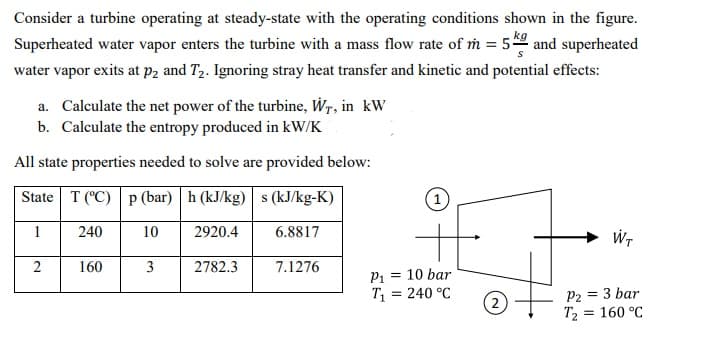Consider a turbine operating at steady-state with the operating conditions shown in the figure. Superheated water vapor enters the turbine with a mass flow rate of m = 5 and superheated water vapor exits at p2 and T2. Ignoring stray heat transfer and kinetic and potential effects: a. Calculate the net power of the turbine, Wr, in kW b. Calculate the entropy produced in kW/K All state properties needed to solve are provided below: State T (C) p (bar) h (kJ/kg) s (kJ/kg-K) 1 240 10 2920.4 6.8817 Wr 2 160 3 2782.3 7.1276 P1 = 10 bar T = 240 °C P2 = 3 bar T2 = 160 °C %3D (2) %3D
Consider a turbine operating at steady-state with the operating conditions shown in the figure. Superheated water vapor enters the turbine with a mass flow rate of m = 5 and superheated water vapor exits at p2 and T2. Ignoring stray heat transfer and kinetic and potential effects: a. Calculate the net power of the turbine, Wr, in kW b. Calculate the entropy produced in kW/K All state properties needed to solve are provided below: State T (C) p (bar) h (kJ/kg) s (kJ/kg-K) 1 240 10 2920.4 6.8817 Wr 2 160 3 2782.3 7.1276 P1 = 10 bar T = 240 °C P2 = 3 bar T2 = 160 °C %3D (2) %3D
Elements Of Electromagnetics
7th Edition
ISBN:9780190698614
Author:Sadiku, Matthew N. O.
Publisher:Sadiku, Matthew N. O.
ChapterMA: Math Assessment
Section: Chapter Questions
Problem 1.1MA
Related questions
Question

Transcribed Image Text:Consider a turbine operating at steady-state with the operating conditions shown in the figure.
Superheated water vapor enters the turbine with a mass flow rate of m = 5 and superheated
water vapor exits at p2 and T2. Ignoring stray heat transfer and kinetic and potential effects:
a. Calculate the net power of the turbine, Wr, in kW
b. Calculate the entropy produced in kW/K
All state properties needed to solve are provided below:
State T (°C) p (bar) h (kJ/kg) s (kJ/kg-K)
(1
1
240
10
2920.4
6.8817
Wr
2
160
3
2782.3
7.1276
P1 = 10 bar
T = 240 °C
= 3 bar
(2)
P2
T2 = 160 °C
Expert Solution
Step 1
(a)
Write the formula for the net power generated in the turbine.
Here, is the mass flow rate of the turbine, h1 is the enthalpy of the water vapor at state 1, h2 is the enthalpy of the water vapor at state 2, and is the net power generated in the turbine.
Step by step
Solved in 2 steps

Knowledge Booster
Learn more about
Need a deep-dive on the concept behind this application? Look no further. Learn more about this topic, mechanical-engineering and related others by exploring similar questions and additional content below.Recommended textbooks for you

Elements Of Electromagnetics
Mechanical Engineering
ISBN:
9780190698614
Author:
Sadiku, Matthew N. O.
Publisher:
Oxford University Press

Mechanics of Materials (10th Edition)
Mechanical Engineering
ISBN:
9780134319650
Author:
Russell C. Hibbeler
Publisher:
PEARSON

Thermodynamics: An Engineering Approach
Mechanical Engineering
ISBN:
9781259822674
Author:
Yunus A. Cengel Dr., Michael A. Boles
Publisher:
McGraw-Hill Education

Elements Of Electromagnetics
Mechanical Engineering
ISBN:
9780190698614
Author:
Sadiku, Matthew N. O.
Publisher:
Oxford University Press

Mechanics of Materials (10th Edition)
Mechanical Engineering
ISBN:
9780134319650
Author:
Russell C. Hibbeler
Publisher:
PEARSON

Thermodynamics: An Engineering Approach
Mechanical Engineering
ISBN:
9781259822674
Author:
Yunus A. Cengel Dr., Michael A. Boles
Publisher:
McGraw-Hill Education

Control Systems Engineering
Mechanical Engineering
ISBN:
9781118170519
Author:
Norman S. Nise
Publisher:
WILEY

Mechanics of Materials (MindTap Course List)
Mechanical Engineering
ISBN:
9781337093347
Author:
Barry J. Goodno, James M. Gere
Publisher:
Cengage Learning

Engineering Mechanics: Statics
Mechanical Engineering
ISBN:
9781118807330
Author:
James L. Meriam, L. G. Kraige, J. N. Bolton
Publisher:
WILEY